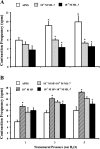Inhibition of myosin light chain phosphorylation decreases rat mesenteric lymphatic contractile activity
- PMID: 19525378
- PMCID: PMC2724206
- DOI: 10.1152/ajpheart.00312.2009
Inhibition of myosin light chain phosphorylation decreases rat mesenteric lymphatic contractile activity
Abstract
Muscular lymphatics use both phasic and tonic contractions to transport lymph for conducting their vital functions. The molecular mechanisms regulating lymphatic muscle contractions are not well understood. Based on the well-established finding that the phosphorylation of myosin light chain 20 (MLC(20)) plays an essential role in blood vessel smooth muscle contraction, we investigated if phosphorylated MLC(20) (pMLC(20)) would modulate the tonic and/or phasic contractions of lymphatic muscle. The effects of ML-7, a MLC kinase inhibitor (1-10 microM), were tested on the contractile parameters of isolated and cannulated rat mesenteric lymphatics during their responses to the known modulators, pressure (1-5 cm H(2)O) and substance P (SP; 10(-7) M). Immunohistochemical and Western blot analyses of pMLC(20) were also performed on isolated lymphatics. The results showed that 1) increasing pressure decreased both the lymphatic tonic contraction strength and pMLC(20)-to-MLC(20) ratio; 2) SP increased both the tonic contraction strength and phosphorylation of MLC(20); 3) ML-7 decreased both the lymphatic tonic contraction strength and pMLC(20)-to-MLC(20) ratio; and 4) the increase in lymphatic phasic contraction frequency in response to increasing pressure was diminished by ML-7; however, the phasic contraction amplitude was not significantly altered by ML-7 either in the absence or presence of SP. These data provide the first evidence that tonic contraction strength and phasic contraction amplitude of the lymphatics can be differentially regulated, whereby the increase in MLC(20) phosphorylation produces an activation in the tonic contraction without significant changes in the phasic contraction amplitude. Thus, tonic contraction of rat mesenteric lymphatics appears to be MLC kinase dependent.
Figures








References
-
- Albert AP, Saleh SN, Large WA. Identifivation of canonical transient receptor potential (TRPC) channel proteins in native vascular smooth muscle cells. Curr Med Chem 16: 1158–1165, 2009. - PubMed
-
- Amerini S, Ziche M, Greiner ST, Zawieja DC. Effect of substance P on mesenteric lymphatic contractility in the rat. Lymphat Res Biol 2: 2–10, 2004. - PubMed
-
- Benoit JN, Zawieja DC, Goodman AH, Granger HJ. Characterization of intact mesenteric lymphatic pump and its responsiveness to acute edemagenic stress. Am J Physiol Heart Circ Physiol 257: H2059–H2069, 1989. - PubMed
-
- Chang S, Hypolite JA, DiSanto ME, Changolkar A, Wein AJ, Chacko S. Increased basal phosphorylation of detrusor smooth myosin in alloxan-induced diabetic rabbit is mediated by upregulation of Rho-kinase β and CPI-17. Am J Physiol Renal Physiol 290: F650–F656, 2006. - PubMed
Publication types
MeSH terms
Substances
Grants and funding
LinkOut - more resources
Full Text Sources
Other Literature Sources

